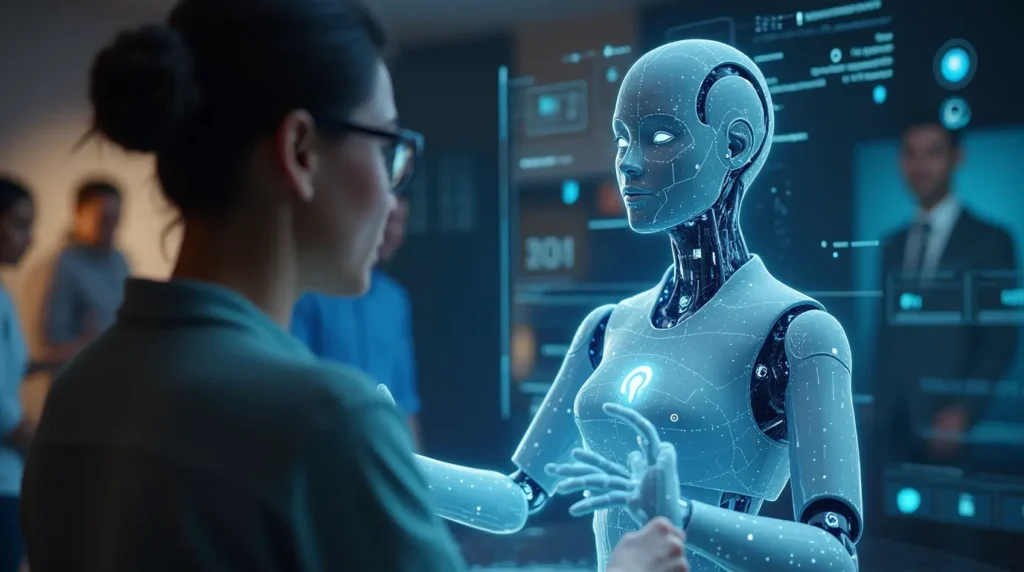What is an AI Humanizer? Tools and Benefits Explained
In recent years, artificial intelligence (AI) has made remarkable advancements, particularly in its ability to interact with humans in ways that feel more natural and intuitive. A key innovation that’s been gaining attention is the AI Humanizer — a tool designed to make interactions with AI more human-like. Whether you’re interacting with a chatbot, using a voice assistant, or engaging with AI-driven content, the role of AI humanizers is becoming more integral in creating a seamless and relatable user experience. In this article, we’ll explore what AI humanizers are, how they work, the best tools of 2024, their benefits, and their applications across various industries.
Table of Contents
Introduction to AI Humanizers: The Basics
An AI humanizer is a technology that makes artificial intelligence (AI) tools appear more human-like in their interactions. These systems use advanced algorithms, such as natural language processing (NLP) and machine learning (ML), to analyze, process, and respond to human input in ways that are conversational and emotionally intelligent. In short, AI humanizers work by bridging the gap between human communication and machine responses, making AI more approachable, relatable, and effective in everyday tasks.
The growing interest in human-like interactions stems from the increasing role AI plays in our daily lives. From virtual assistants like Siri and Alexa to customer service chatbots, AI has become an essential part of various industries, and the demand for more engaging and human-centered interactions is at an all-time high.

How Does an AI Humanizer Work?
The technology behind AI humanizers is built on the principles of natural language processing (NLP), machine learning (ML), and, more recently, emotional intelligence. Here’s a breakdown of the technologies that power AI humanizers:
1. Natural Language Processing (NLP)
NLP is a subfield of AI that focuses on the interaction between computers and human language. Through NLP, AI can understand, interpret, and generate human language in a way that feels intuitive. When you speak to a voice assistant or type a question into a chatbot, NLP enables the AI to process your input, recognize intent, and respond appropriately.
2. Machine Learning (ML)
Machine learning enables AI systems to improve their responses over time based on past interactions. ML algorithms allow AI humanizers to adapt to the user’s preferences, tone, and style of communication, making conversations feel more personal and customized.
3. Emotional Intelligence
Perhaps the most exciting advancement in AI humanizers is the integration of emotional intelligence (EQ). Through sentiment analysis and context understanding, AI humanizers can detect the emotional state of a user and respond with the appropriate tone, whether it’s empathetic, excited, or formal. This makes interactions with AI feel more genuine and helps establish rapport, which is especially important in customer service and virtual assistance.
4. Tone, Language, and Context
AI humanizers go beyond simply understanding words — they focus on how words are used. By analyzing sentence structure, word choice, and even context, AI can mimic the natural flow of human conversation, making responses seem more natural. This is particularly useful in voice assistants and chatbots, where understanding the user’s intent is key to providing a relevant response.
Top AI Humanizer Tools of 2024
As the demand for human-like AI grows, several tools have emerged as leaders in the field of AI humanization. These tools use advanced technologies to improve customer experiences, automate tasks, and facilitate more natural interactions. Let’s look at some of the best AI humanizer tools of 2024:
1. ChatGPT by OpenAI
One of the most popular AI-powered tools, ChatGPT, has revolutionized the way businesses and individuals interact with AI. This conversational AI tool is capable of generating human-like text responses based on the input it receives. It’s widely used for customer support, content creation, and even creative tasks like storytelling.
2. Amazon Alexa
Alexa, Amazon’s virtual assistant, is another well-known AI humanizer. By incorporating voice recognition and natural language understanding, Alexa can respond to questions, manage smart home devices, and even engage in casual conversations. With improvements in emotional intelligence and conversational context, Alexa is constantly getting better at human-like interactions.
3. Google Dialogflow
Google’s Dialogflow is a cloud-based conversational AI tool that helps businesses build chatbots and voice assistants with human-like capabilities. By leveraging NLP and machine learning, Dialogflow can understand and generate responses based on context, ensuring that conversations flow smoothly and feel more natural.
4. IBM Watson Assistant
IBM Watson Assistant is another powerful AI tool that humanizes customer interactions. It’s known for its ability to create intelligent virtual assistants that can understand and respond in natural language. Watson’s machine learning capabilities allow it to improve interactions over time, making it a reliable choice for businesses looking to offer seamless customer support.
Benefits of AI Humanizer Technology for Businesses and Individuals
AI humanizers offer numerous benefits for both businesses and individuals. Let’s explore how this technology can make a significant impact:
For Businesses:
- Improved Customer Support: AI-powered chatbots and virtual assistants can handle customer queries 24/7, providing immediate and personalized responses. This not only improves customer satisfaction but also reduces the workload on human support agents.
- Enhanced User Experience: By making interactions feel more natural and personalized, businesses can offer a more engaging user experience. AI humanizers can adjust their tone and responses based on the customer’s mood or sentiment, making users feel heard and valued.
- Cost Efficiency: Automating customer support and other routine tasks with AI reduces the need for large support teams, allowing businesses to allocate resources more efficiently.
For Individuals:
- Personalized Assistance: AI humanizers, like virtual assistants, can adapt to your preferences, managing tasks like scheduling, reminders, and even controlling smart home devices.
- Efficiency and Convenience: With AI taking care of mundane tasks, individuals can save time and focus on more meaningful activities.
- Better Communication: AI humanizers are designed to interact in a way that’s not only intelligent but also relatable. This improves communication, whether it’s with an AI assistant or a customer service bot.
Real-World Applications of AI Humanizers
AI humanizers are being implemented across various industries to improve customer experiences, streamline workflows, and enhance productivity. Here are some examples of how AI humanizers are making a difference:
Healthcare
AI humanizers are revolutionizing healthcare by powering virtual medical assistants that interact with patients. These assistants can answer questions, provide health advice, and even schedule appointments. By offering empathetic and personalized responses, AI humanizers are making healthcare more accessible and user-friendly.
Customer Service
Many businesses are using AI humanizers in customer service. Chatbots with advanced NLP and emotional intelligence capabilities can handle customer inquiries efficiently and provide personalized solutions. This not only enhances the customer experience but also helps businesses manage high volumes of requests.
E-Commerce
In e-commerce, AI humanizers are used to create personalized shopping experiences. Virtual shopping assistants can recommend products based on customer preferences, engage with shoppers in real time, and assist with purchases, making the shopping process more enjoyable and efficient.
The Future of Human-Like AI
As AI technology continues to evolve, the future of human-like AI is incredibly promising. In the next few years, we can expect the following advancements in AI humanizer technology:
- Emotional AI: AI will become even better at recognizing and responding to human emotions, making interactions even more personalized and empathetic.
- Deep Learning: AI will continue to improve through deep learning techniques, allowing it to better understand complex contexts and provide more accurate responses.
- Increased Integration: AI humanizers will become more deeply integrated into everyday applications, from personal assistants to workplace tools. As AI gets better at understanding context and delivering human-like interactions, it will play a crucial role in various aspects of life, including education, therapy, and business.

FAQ Section
1. What is an AI Humanizer?
An AI humanizer is a tool or system designed to make artificial intelligence interactions more human-like. By using advanced technologies such as natural language processing and machine learning, these tools enable AI to mimic human behavior, such as emotional responses and nuanced conversation.
2. How do AI Humanizers Work?
AI humanizers work by processing human language, tone, and context to generate responses that seem natural and engaging. They use algorithms that analyze emotional cues, sentence structure, and user preferences to make interactions feel more personalized and intuitive.
3. What Are Some Popular AI Humanizer Tools?
Some top AI humanizer tools in 2024 include advanced chatbots like ChatGPT, voice assistants like Amazon Alexa, and speech synthesis tools that can replicate human-like voice tones. These tools are designed for a variety of applications, including customer service, virtual assistants, and more.
4. How Can Businesses Benefit from AI Humanizers?
Businesses can enhance customer service, improve user experience, and increase engagement by using AI humanizers. By integrating AI into customer support or communication systems, businesses can provide faster, more efficient, and empathetic responses, increasing customer satisfaction and loyalty.
5. What Are Some Real-World Applications of AI Humanizers?
AI humanizers are used in many industries, such as healthcare for virtual medical assistants, in e-commerce for personalized shopping experiences, and in customer support for handling inquiries through AI-powered chatbots. They are also used in voice assistants, making interactions smoother and more natural.
6. What is the Future of AI Humanizers?
The future of AI humanizers includes continued improvements in emotional AI, making interactions even more realistic. As AI humanizers evolve, they will play an even bigger role in areas like education, therapy, and the workplace, assisting with more
human-like communication and decision-making processes.
Conclusion
AI humanizers are transforming the way we interact with technology, making AI feel more approachable, intuitive, and responsive. As we continue to witness advancements in machine learning, emotional intelligence, and natural language processing, the future of AI promises even more realistic and engaging experiences. Whether you’re a business looking to improve customer support or an individual seeking a more personalized virtual assistant, AI humanizers are here to stay — and they will only get better with time.


